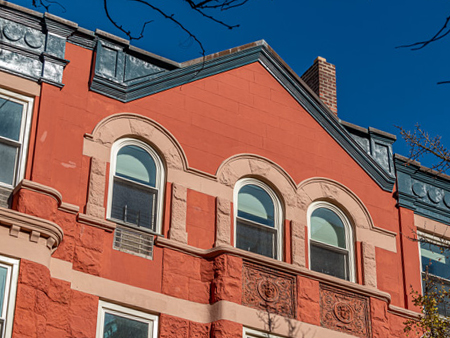By Katie Frasier
This article originally appeared in ENR Mountain States.
During the past several years, the green building trend has soared, with an increase in government incentives and availability of affordable supplies driving a huge growth of U.S. Green Building Council LEED-certified buildings. With the LEED program ambitiously hoping to certify one million commercial buildings by 2020, it’s no surprise that this trend has come under some scrutiny. And while most great rewards often have a price, in this case it could be at the expense of the safety of construction workers on the job.
When Matthew Hallowell, assistant professor in the Civil, Environmental and Architectural Engineering Department at the University of Colorado Boulder, became aware of a study that found evidence of a nearly 50 percent increase of injury rate had occurred in LEED-certified projects over traditional construction, he found himself wondering about the cause. “That original work was the catalyst,” Hallowell says. “What we proposed to do was a comprehensive analysis where we looked credit by credit at the construction and design for this type of building and how that compared to what we traditionally do. LEED is growing very quickly, but prior to this, no one had paid much attention to the safety involved.”
The team’s greatest challenge in conducting the study, titled “Identification of Safety Risks for High-Performance Sustainable Construction Projects,” was gathering empirical data rather than opinion-based anecdotes. To do this, Hallowell says the student researcher conducted site visits, observed construction processes, obtained and analyzed project documentation and reviewed job-hazard analyses and injury reports—in addition to conducting interviews at multiple organizational levels. With the information gathered, Hallowell and his team of researchers were able to identify 14 LEED credentials that may create heightened risks to construction workers.
Most notable risks include a perceived 41% higher risk associated with installing sustainable roofing, a perceived 37% increase in risk from installing PV panels for on-site renewable energy, a perceived 36% additional risk of cuts, abrasions and lacerations from construction waste management and perceived 32% heightened risk of falls from installing skylights and atriums to meet the daylight and views credit.
“I was very surprised when I read the conclusions,” says Brendan Owens, vice president of LEED Technical Development at USGBC. “LEED buildings are substantively different than non-LEED buildings and while there are risks in all construction, we did not expect green-building construction would have higher incidence of accidents. I don’t know that a lot of people would have held an opinion that was different than mine prior to this report.” The fact that the LEED rating system had yet to identify how to improve workers’ safety was something the USGBC had already been working closely with the National Institute of Occupational Safety and Health (NIOSH) for several months to evaluate.
“We understood there were opportunities to learn from the safety community and help take their expertise to understand where we could create LEED credit language that inherently values the mitigation of risks to the constructors,” says Owens. “Still, it’s helpful and important that people are studying these issues and identifying opportunities to get better.” One question that arose from these studies was whether a building could truly be considered sustainable if the health and safety of its constructors were at risk. “Worker safety and health must be considered as an integral component of sustainable building design, construction and operation,” says Hallowell.
He reasons that adding LEED credentials based on safety measures would be beneficial to maintaining worker safety. But Owens notes that rather than putting in place a credential that recognizes regulations contractors should already be complying with, LEED officials are looking to evolve the rating system as a whole. “Right now we’re trying to understand where the leverage points are within the rating system for opportunities that will allow us to make it better,” says Owens. “If we can become better informed about risks involved, we can improve the requirements of the rating systems and enhance safety.
This study is an initial step in that direction.” Whether the findings of this study have surprised or validated opinions of individuals around the industry, Owens asserts that the information is useful for everyone to consider. “I really hope that people will be looking at this study and learning from it.
That’s certainly what we’ll be doing.”
Examples of Identifying and Reducing Risks
In addition to identifying the increased risks in building for LEED certification, Hallowell and his team followed up with a study (due to publish in February) that found suggested mitigations for the added risks. It’s important to note that though these are listed under the LEED credential the construction methods meet, many of these risks are not unique to green building. Prevention efforts can also be applied to construction of traditional buildings that might incorporate one or more of these elements.
LEED Credit: Brownfield Redevelopment
Identified Risk: Extensive earthwork operations create a higher risk of falling or collapsing and hazards from the disposal of contaminants. Suggested Mitigation: Workers could use impermeable plastic liners in the beds of heavy equipment and thoroughly wash all equipment at the end of each workday to reduce contamination.
LEED Credit: Stormwater Quality Control
Identified Risk: Workers have an increased risk of falling from increased excavation and trenching.
Suggested Mitigation: Designing detention ponds with gradual slopes to avoid steep embankments may help reduce risk of falling. Contractors could plan concurrent tasks away from the excavation. LEED Credit: Heat Island Effect—Roof Identified Risk: White roofing options can be heavier and slipperier than traditional black roofing material, which increases the risk for overexertion and falls. The bright material can interrupt line of sight and increase the risk of slips and falls during installation.
Suggested Mitigation: Tan or light gray membranes could be used to decrease reflectivity, or contractors could require tinted eyewear. Rubber walkpads could be provided for added traction, and contractors could purchase a greater number of smaller rolls to avoid overexertion from weight.
LEED Credit: Innovative Wastewater Technologies
Identified Risk: Risk of exposure to hazardous chemicals comes from construction a dual waste water system from installing additional piping.
Suggested Mitigation: Contractors might require non-polyester gloves and respiratory protection and employ extensive quality-control measures.
LEED Credit: Optimize Energy Performance
Identified Risk: An increased risk of falling comes from a more ladder time installing added wires and controls, and double caulking.
Suggested Mitigation: Designers could incorporate prefabricated panels of the exterior skin system, framing, structure and vapor barrier, and contractors could caulk from the building’s interior before installing finishing materials. LEED Credit:
On-Site Renewable Energy
Identified Risk: Falls and overexertion are more likely from installing heavy PV panels, usually on the roof.
Suggested Mitigation: Designers could place PV panels closer to the ground or keep them as far from the edge of the roof as possible. Higher parapets and designed tie-off points may also lessen the risk of falling.
LEED Credit: Enhanced Commissioning
Identified Risk: The presence of commissioners distracts workers, increasing risk of falls and injuries.
Suggested Mitigation: Commissioning agents could receive a site-specific orientation and be provided with personal protective equipment. Agents could be required to pass an OSHA safety course.
LEED Credit: Construction Waste Management
Identified Risk: “Dumpster diving” to retrieve mistakenly trashed recyclable materials increases risk of sprains and cuts.
Suggested Mitigation: Suggested solutions include utilizing a third-party, local waste management company to sort the recyclable material offsite, using multiple, smaller waste receptacles around the construction site, or creating an industry-wide, color-coded labeling system to differentiate recycling from trash.
LEED Credit: Outdoor Air Delivery Monitoring
Identified Risk: Time spent at heights to wire and mount the permanent monitoring system increases risk of falls.
Suggested Mitigation: This risk may be eliminated by incorporating the monitoring equipment into the prefabrication process.
LEED Credit: Construction IAQ Management Plan Identified Risk: A higher risk of falls and overexertion occurs from increased ladder time maintaining ductwork.
Suggested Mitigation: Using different materials for the prefabricated “caps” on the ends of the duct, such as a universal magnetic cap, may make installation less awkward and therefore quicker and easier. Also suggested was the off-site fabrication of ductwork for longer sections to decrease time spent on the ladder.
LEED Credit: Low-Emitting Materials—Adhesives/Sealants
Identified Risk: Oftentimes, “rework” is needed due to the lower quality low-emitting adhesives and sealants used. The added time spent at heights, performing overhead work and exposure to construction dust creates a heightened risk for workers.
Suggested Mitigation: Designers and contractors could work together to find available products that meet Rule #1168 while also standing up to expected temperatures and compatibility to other construction materials used. This would eliminate the need for added “rework.”
LEED Credit: Indoor Chemical and Pollutant Source Control
Identified Risk: Workers have a heightened risk to fall hazards due to overhead work and working at heights during piping and ductwork installation.
Suggested Mitigation: Designers could install HVAC systems under the floor so they’re easier to install and maintain.
LEED Credit: Controllability of Systems—Lighting
Identified Risk: Complex wiring associated with occupancy sensors and timing controls increase risk of electrical shock to workers. Additional time spent wiring these systems at heights increases the risk of falls.
Suggested Mitigation: Some elements of the systems could potentially be prefabricated, decreasing time spent working with the wires onsite. Designers might locate sensors at reachable heights rather than on ceilings to eliminate time spent of ladders.
LEED Credit: Daylight and Views: Daylight 75% of Spaces
Identified Risk: Large skylights, windows or atriums increase time spent working near large, exposed openings at great heights.
Suggested Mitigation: Designers could create a courtyard to meet the requirements or minimize the depth of the building as an alternative to atriums and skylights. If these elements are included, additional precautions could be taken, such as blocking off areas below overhead work, using equipment such as man lifts and scissor lifts when possible and using tie-offs and barriers near exposed openings.
Katie Frasier is a freelance construction writer and social media specialist in charge of promoting jobsite safety. She has a background in magazine journalism and has previously written for a number of national publications. Reach her at www.workboots.com or e-mail: Katie@cat5.com.



